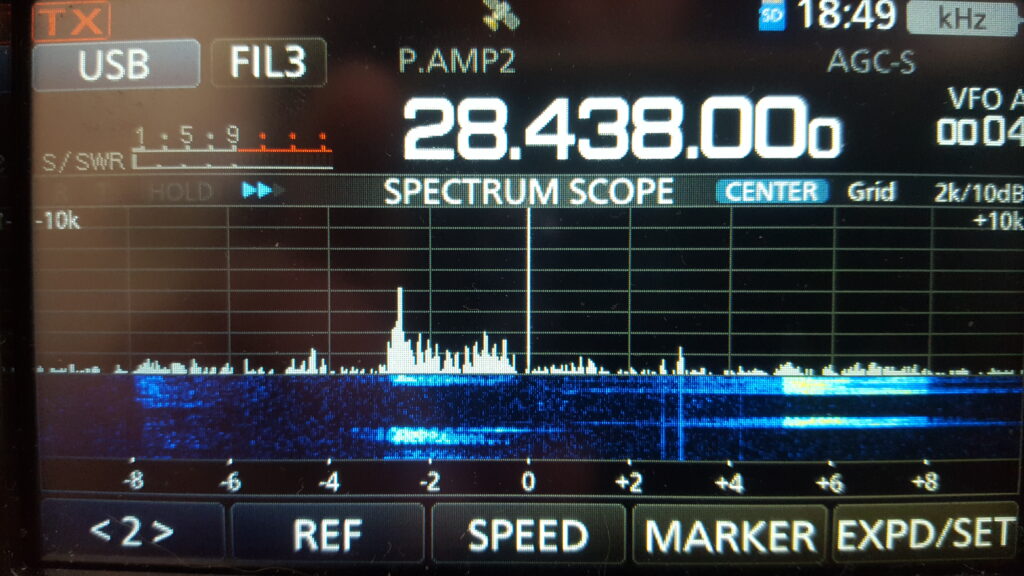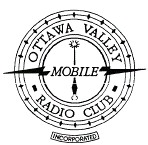Introduction
The Icom IC-705 multi-mode QRP transceiver has been around for a couple of years and has been the subject of many product reviews. Its notoriety as a top line QRP radio, my desire to have a full-function QRP radio for Field Day and not having spent any significant money on my ham radio hobby in many years ended up in my buying one just before Christmas 2022. Nearly three months have passed exploring this new rig and now it's time to let you know what I think about it.
This review focuses more on the rig's RF performance and its ability to both pull signals out of the noise as well as shield desired signals from interferers. I could go into the digital side of things and the D-Star functionality, but that would take another couple of months of operating and not really enhance what I think is important to the average radio user. So here goes.
First Impressions
The first thing that struck me about this radio was Icom's attempt to jam as many features as possible into a rather small package. This radio may be difficult to work for people with fat fingers. The SD memory card is very hard to access, being tight against the front screen casting and speaker/mic cord retainer and also being under a rubber dust cap. Working the SD card in and out of its receptacle risks card breakage and I actually resorted to using a hemostat to position the card before clicking it into place. Fortunately, the SD card contents are accessible via a USB data link so this shouldn't give too much grief in the future. There are a few rubber dust cover flaps on various interfaces which are rather small and require some care to move out of the way, e.g. for attaching a micro USB cable, a CW key and the accessory ports. So much for the down side, the rest of it is well thought by Icom.
Icom offers free setup/backup software for their radios. I found the CS-705 configuration and data backup management software for Windows® to be very intuitive and easy to use. I didn't need to read the software user guide at all to figure out how the software works.
My radio came with firmware V1.26 installed, which was adequate for most of my initial assessments but I did end up updating it to the latest V1.32. It's a straightforward process with adequate procedural safeguards along the way which help avoid bricking the radio.
The audio quality from the radio's main speaker is surprisingly good for a 1 inch speaker, being loud enough for use in a vehicle without noticeable distortion with the volume level at 75%. The microphone speaker isn't nearly as good and I wouldn't use it unless the situation demands it. Still, it's a good idea on Icom's part to have separate speaker and mic connections to the radio, allowing flexibility for the user to use whatever audio devices work best.
The master oscillator can be adjusted in real time and with very fine granularity to take out any incidental tuning error. I'm a bit finicky for things like this and found that the factory setting of 47.2% was on the low side when monitoring the WWV signal on 25 MHz. I use a technique of switching between USB and LSB on a known standard CW signal to figure how good the radio's tuning accuracy may be. Switching between modes will result in an audible tone on both sides and it's only when the two tones are perceived as equal in frequency that the radio is actually receiving a signal at an RF frequency coincident with what's indicated by the VFO dial. Most people can detect a difference of around 3 Hz. in tones across a 500-1000 Hz. range which is more than enough to have your radio tuning adequately close to the real RF frequency. In my case the USB/LSB method led me to adjusting the Ref Oscillator to 52% from its original of 42.7. It's important when receiving a signal on the air that the highest possible RF signal should be found as Ref Oscillator errors multiply up with increasing frequency and can be quite high when in the 70 cm. band. Also, to allow the radio to stabilise at the manufacturer's nominal ambient temperature (typically around 21º C.) for at least a half hour after power-up.
Lastly, the operating menus are arranged quite logically as accessed through the front panel row of keys below the LCD display. The Menu key is equivalent to "what do I want to do?" and the Function key is equivalent to "how do I want to do it". A very smart way to operate a radio in my view.
Spectrum/Waterfall Display
The Spectrum/Waterfall Display (I'll call it a panadaptor for brevity) has exceptionally good resolution and sweep speed; I'd say it's comparable to a high end consumer grade spectrum analyser.
The frequency span settings are good, ranging from ±2.5 kHz. to ±500 kHz. There is some automatic resolution bandwidth adjustment being done among the different span settings as the displayed noise floor increases with wider span. If you want to keep the displayed noise floor at a constant level, this can be done by adjusting the panadaptor Ref control. In most cases the noise floor can be adjusted to be just visible but there are cases, given the very low noise of the radio's RF section, where one of the built-in RF preamplifiers may have to be enabled.
While the visible span is adjustable, the vertical level scaling is fixed. Something of a niggle with me; I mean with all the DSP horsepower in the IC-705 why can't the vertical scale be adjustable to pick out those really marginal signals, but there it is.
One very useful panadaptor tool is what I call a Point & Shoot feature. If a signal pops up and you want to tune to it quickly, all you have to do is touch the screen near where the signal appeared, a magnified snapshot of that area is taken and then touch again on the desired signal to tune the radio. I can see this being very useful in a contest or Field Day.
SSB Reception
I can summarise the SSB performance of this radio as being nothing less than exceptional. Adjacent channel and opposite sideband rejection are very good. Figure 1 shows an example of being able to pick out a relatively weak signal in the presence of a much stronger signal in the alternate sideband's passband. In this case I could detect no interference whatsoever from the stronger signal. Similarly, for signals outside the radio's IF passband, called FIL in Icom-speak, the filters are very sharp. I could find weak signals in the presence of a much stronger signal only 3 kHz. away and again had no interference issues.

Figure 1 - SSB Isolation
On the subject of IF filter passbands, the IC-705 does have the ability to shift the IF filter skirt positions using the PassBand Tuning, PBT, feature. I tried using this a few times but found in most cases it really isn't necessary because of the inherently sharp IF filtering already available. Nevertheless, it's a useful feature to have in particularly difficult interference situations. The PBT adjustment is done via a popup window but I did find the window's timeout delay to be rather short. I think I'll be sending ICOM a note about this with a suggestion to lengthen it in the next firmware release.
The DSP noise reduction is quite effective and, unlike that implemented in late model Yaesu radios, is apparently a single noise reduction algorithm that is applied in increasing levels of aggressiveness. I found the DSP-NR on the 705 to be much superior to that on my FT-991A.
The DSP Auto-Notch and manual notch filters work quite well. Auto-notch will eliminate most of the annoying tuner-uppers that appear occasionally when having a conversation without having any noticeable effect on the quality of the desired signal.
CW Operation
The first thing that struck me when looking at CW signals was the obvious phase noise envelope around all the carriers.

Figure 2 - CW Spectrum
At first I thought oh boy this isn't good, but then I tuned to WWV on its 10/15/20/25 MHz. signals and saw that their carriers were dead clean. Well, that can only mean that what we're seeing with CW is the phase noise behaviour of most radio transmitters on the air today. Despite this, there doesn't seem to be any additional noise at audio level so, for a ham radio operation, things are ok.
Selectivity at a 250 Hz. IF filter setting, FIL3, is quite good. There is complete isolation between signals I found having a 30 dB. level difference. I could easily pick out the desired weak signal in the presence of an interferer 500 Hz. away. I could only dream of this kind of performance with my old FT-101E; even with a CW crystal filter installed.

Figure 3 - CW Isolation
The only CW features missing from the IC-705 are carrier zero-beat tools that are on the FT-991A. These are the Yaesu SPOT function to zero-beat to a CW signal manually and ZIN which will automtically zero-beat without having to fiddle with the VFO.
FM Operation
There's not much to be said about FM operation with this radio since it has features common to many FM amateur rigs. The basic setup and memory/scan of repeater frequencies is easy to understand and works quite well. A very helpful feature is the CTCSS Tone scan feature which will scan and automatically identify a repeater's transmitted PL tone. Something very useful when on the road and in an unfamiliar region where there's no immediate access to information about the local repeaters.
RTTY Operation
The IC-705 has a built-in RTTY codec. It defaults to the 45 Baud standard commonly used with amateur radio but the RTTY speed and tone offsets can be tailored if you want to listen in on other RTTY transmissions in the HF bands. I had the chance to check out the RTTY decoder performance during a recent RTTY contest and it behaved quite well. Coupled with the Point & Shoot panadaptor feature I mentioned before, it was easy to move quickly from one signal to another. Isolation from interferers was very good when using the FIL3 setting.
Transmitting with the built-in RTTY codec is rather limited as it only allows sending preset scripts that are stored in memory, so the user has to set up these scripts before embarking on a contest and hope that the exchange format doesn't change. Nevertheless, the built-in RTTY capability can be useful on in-the-field events such as Parks On The Air.
Conclusion
That's as far as I've come with assessing this radio. It's a very fine product, although pricey running at C$2000.00 when buying in Canada including the taxes and shipping. Still, it's jam packed with all the features of a desktop radio and the DSP-FPGA engines work exceptionally well. It's a great radio for someone looking to go QRP which seems to be a growing interest these days. Some reviews have said that while the IC-705 is a fine radio, they would never take it out in the field simply because they wouldn't even want to think about losing an expensive radio like this if their canoe were to tip over. Well, true enough, but I guess it's up to the individual as to what they want to pack in their getaway kit.
Outside of all that, I'll conclude with saying that I'll be keeping this radio for a long time. I see nothing on the horizon that can beat it for features and performance.
Cheers to all and 73,
Hugo, VE3KTN
Appears in: Rambler Vol 65 Issue 7, March 2023
